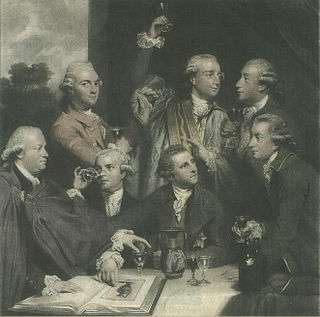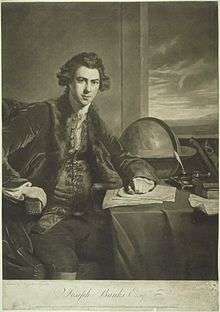Society of Dilettanti

The Society of Dilettanti (founded 1734) is a society of noblemen and scholars which sponsors the study of ancient Greek and Roman art, and the creation of new work in the style.
History
Though the exact date is unknown, the Society is believed to have been established as a London dining club in 1732[1] by a group of people who had been on the Grand Tour. Records of the earliest meeting of the Society were written somewhat informally on loose pieces of paper. The first entry in the first minute book of the Society is dated April 5, 1736.[2]
In 1743 Horace Walpole condemned its affectations and described it as such; "...a club, for which the nominal qualification is having been in Italy, and the real one, being drunk: the two chiefs are Lord Middlesex and Sir Francis Dashwood, who were seldom sober the whole time they were in Italy"[3]
The group, initially led by Francis Dashwood, contained several dukes and was later joined by Joshua Reynolds, David Garrick, Uvedale Price and Richard Payne Knight, among others. It was closely associated with Brooks's, one of London's most exclusive gentlemen's clubs. The society quickly became wealthy, through a system in which members made contributions to various funds to support building schemes and archaeological expeditions.
The first artist associated with the group was George Knapton.
The Society of Dilettanti aimed to correct and purify the public taste of the country; from the 1740s, it began to support Italian opera. A few years before Sir Joshua Reynolds became a member, the group worked towards the objective of forming a public academy, and from the 1750s, it was the prime mover in establishing the Royal Academy. In 1775 the club had accumulated enough money towards a scholarship fund for the purpose of supporting a student's travel to Rome and Greece, or for archaeological expeditions such as that of Richard Chandler, William Pars and Nicholas Revett, the results of which they published in Ionian Antiquities, a major influence on neo-Classicism in Britain.
Membership
The Society has 60 members, elected by secret ballot. An induction ceremony is held at a London club. It makes annual donations to the British Schools in Rome and Athens, and a separate fund set up in 1984 provides financial assistance for visits to classical sites and museums.
Notable members


- Thomas Anson (founder member)
- Right Honourable Sir Joseph Banks
- George Beaumont
- Rev. Clayton Mordaunt Cracherode
- Anthony Morris Storer, Esq.[5]
- Charles Crowle, Esq.
- Henry Dawkins of Standlynch Hall, Wiltshire
- Francis Dashwood, 11th Baron le Despencer (founder member)
- Lord Dundas
- Sir Henry Englefield
- Stephen Payne-Gallwey, Esq.
- David Garrick
- Sir James Gray, 2nd Baronet (founder member)
- Sir George Gray, 3rd Baronet (founder member)
- The Honourable Charles Francis Greville
- Sir William Hamilton (diplomat)
- Thomas Hope
- Philip Metcalfe (since 1786)
- Richard Payne Knight (since 1781)
- Duke of Leeds
- Constantin John Lord Murlgrave
- Uvedale Price
- Sir Joshua Reynolds (since 1766)
- Lord Seaforth
- John Spencer, 1st Earl Spencer
- Spencer Stanhope, Esq.
- Sir John Taylor, 1st Baronet
- Richard Thompson, Esq.
- Sir Anthony R Wagner, Garter Principal King of Arms
- William Wilkins
- Sir Watkin Williams-Wynn, 4th Baronet
- Charles Watkin Williams-Wynn (elder)
- Sir Charles Watkin Williams-Wynn (younger)
- Charles Towneley, antiquary and collector
References and sources
- References
- ↑ Kelly, Jason M. The Society of Dilettanti: archaeology and identity in the British enlightenment. New Haven: Published for the Paul Mellon Centre for Studies in British Art by Yale University Press, 2009.
- ↑ Cust, L; Colvin, S (1914). "Antiquity of the Society". History of the Society of Dilettanti. London: Macmillan and Company, Ltd. pp. 1–21.
- ↑ Horace Walpole, quoted in Jeremy Black, The British and the Grand Tour (1985), p120
- ↑ "Grecian Taste and Roman Spirit: The Society of Dilettanti". Getty Villa Exhibitions. J. Paul Getty Trust. 2008. Retrieved 28 November 2010.
- ↑ Dictionary of National Biography, Volume 22 Page 1243
- Sources
- The Penguin Dictionary of British and Irish History, editor: Juliet Gardiner
- This article incorporates text from a publication now in the public domain: Wood, James, ed. (1907). "article name needed". The Nuttall Encyclopædia. London and New York: Frederick Warne.
- This article incorporates text from:The Life of Sir Joshua Reynolds, Volume 2, James Northcote, 1819
Further reading
- Dorment, Richard. The Dilettanti: exclusive society that celebrates art (Daily Telegraph 2 September 2008)
- Harcourt-Smith, Sir Cecil and George Augustin Macmillan, The Society of Dilettanti: Its Regalia and Pictures (London: Macmillan, 1932).
- Kelly, Jason M., The Society of Dilettanti: Archaeology and Identity in the British Enlightenment (New Haven and London: Yale University Press and the Paul Mellon Centre for Studies in British Art, 2009).
- Redford, Bruce, Dilettanti: The Antic and the Antique in Eighteenth-century England (Los Angeles: J. Paul Getty Museum, 2008).
- Simon, Robin, “Reynolds and the Double-entendre: the Society of Dilettanti Portraits,” The British Art Journal 3, no. 1 (2001): 69-77.
- West, Shearer, “Libertinism and the Ideology of Male Friendship in the Portraits of the Society of Dilettanti,” Eighteenth Century Life 16 (1992): 76–104.
External links
- Review of Bruce Redford, Dilettanti: The Antic and the Antique in Eighteenth-Century England. in Bryn Mawr Classical Review 2008.08.28
- Antiquities of Ionia (Part 1 of 3) Kenneth Franzheim II Rare Books Room, William R. Jenkins Architecture and Art Library, University of Houston Digital Library.